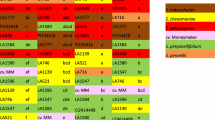Abstract
Greenhouse-grown plants of five tomato lines varying in their level of 2-tridecanone-mediated resistance toManduca sexta (L.) andLeptinotarsa decemlineata (Say) were found to adversely affect larvae ofCampoletis sonorensis (Cameron), a larval endoparasitoid ofHeliothis zea (Boddie), in a manner directly related to their level of resistance. The parasitoid larvae, which emerge as fifth instars from their host and construct a cocoon on the foliage of their hosts' host plant, suffered extensive mortality during cocoon spinning on highly resistant foliage. Mortality was greatest (82%) on the highly resistant plants ofLycopersicon hirsutum f.glabratum (accession PI 134417) and an F1 backcross [(L. esculentum × PI 134417) × PI 134417] selection. Mortality was intermediate (40 and 28%, respectively) on backcross selections with moderate and low levels of resistance and least (8%) on susceptibleL. esculentum. Removal of the glandular trichomes, which contain 2-tridecanone in their tips, from the foliage eliminated differences in parasitoid mortality among plant lines.
Bioassays of 2-tridecanone indicated that it is acutely toxic to fifth instarC. sonorensis larvae at the quantities associated with highly resistant foliage and produces symptoms identical to those observed on resistant foliage. 2-Undecanone, a second methyl ketone present in the glandular trichomes of resistant foliage, was also toxic toC. sonorensis larvae, but significantly less so than 2-tridecanone. The results support the hypothesis that 2-tridecanone is responsible for the observed mortality ofC. sonorensis larvae during cocoon construction on resistant foliage.
Similar content being viewed by others
References
Burton, R.L. 1970. A low-cost artificial diet for the corn earworm.J. Econ. Entomol. 63:1969–1970.
Dimock, M.B., andKennedy, G.G. 1983. The role of glandular trichomes in the resistance ofLycopersicon hirsutum f.glabratum toHeliothis zea.Entomol. Exp. Appl. 33:263–268.
Dimock, M.B., Kennedy, G.G., andWilliams, W.G. 1982. Toxicity studies of analogs of 2-tridecanone, a naturally occurring toxicant from a wild tomato.J. Chem. Ecol. 8:837–842.
Farrar, R.R., Jr., andKennedy, G.G. 1987a. Growth, food consumption and mortality ofHeliothis zea larvae on foliage of the wild tomatoLycopersicon hirsutum f.glabratum and the cultivated tomato,L. esculentum.Entomol. Exp. Appl. 44:213–219.
Farrar, R.R., Jr., andKennedy, G.G. 1987b. 2-Undecanone, a constituent of the glandular trichomes ofLycopersicon hirsutum f.glabratum: Effects onHeliothis zea andManduca sexta growth and survival.Entomol. Exp. Appl. 43:17–23.
Fery, R.L., andKennedy, G.G. 1987. Genetic analysis of 2-tridecanone concentration, leaf trichome characteristics, and tobacco hornworm resistance in tomato.J. Am. Soc. Hortic. Sci. 112:886–891.
Kauffman, W.C. 1987. Influence of 2-tridecanone-based resistance of a wild tomato on parasitoids and predators of the tomato fruitworm. PhD thesis. North Carolina State University, Raleigh, North Carolina 117 pp.
Kennedy, G.G. 1984. 2-Tridecanone, tomatoes andHeliothis zea: Potential incompatibility of plant antibiosis with insecticidal control.Entomol. Exp. Appl. 35:305–311.
Kennedy, G.G. 1986. Consequences of modifying biochemically mediated insect resistance inLycopersicon species, pp. 130–141,in M.B. Green and P.A. Hedin (eds.). Natural Resistance of Plants to Pests. American Chemical Society, Washington, D.C.
Kennedy, G.G., andDimock, M.B. 1983. 2-Tridecanone: A natural toxicant in a wild tomato responsible for insect resistance, pp. 123–128,in J. Miyamoto and P.C. Kearner (eds.). Pesticide Chemistry: Human Welfare and the Environment, Vol. 2, Pergamon Press, Tokyo.
Kennedy, G.G., andSorenson, C.E. 1985. Role of glandular trichomes in the resistance ofLycopersicon hirsutum f.glabratum to Colorado potato beetle (Coleoptera: Chrysomelidae).J. Econ. Entomol. 78:547–551.
Kennedy, G.G.,Sorenson, C.E., andFery, R.L. 1985. Mechanisms of resistance to Colorado potato beetle in tomato, pp. 107–116,in D.N. Ferro and R.H. Voss (eds.). Proceedings of the Symposium on the Colorado Potato Beetle, XVIIth International Congress of Entomology. Massachusetts Agricultural Experiment Station Research Bulletin No. 704. Amherst, Massachusetts.
Kennedy, G.G., Farrar, R.R., andRiskallah, M.R. 1987a. Induced tolerance of neonateHeliothis zea to host plant allelochemicals and carbaryl following incubation of eggs on foliage ofLycopersicon hirsutum f.glabratum. Oecologia 73:615–620.
Kennedy, G.G., Nienhuis, J., andHelentjaris, T. 1987b. Mechanisms of arthropod resistance in tomatoes, pp. 145–154,in D.J. Nevins and R.A. Jones (eds.). Tomato Biotechnology. Alan R. Liss, New York.
Lin, S.Y.H., andTrumble, J.T. 1986. Resistance in wild tomatoes to larvae of a specialist herbivore,Keiferia lycopersicella.Entomol. Exp. Appl. 41:53–60.
Lin, S.Y.H., Trumble, J.T., andKumamoto, J. 1987. Activity of volatile compounds in glandular trichomes ofLycopersicon species against two insect herbivores.J. Chem. Ecol. 13:837–850.
SAS. 1985. SAS User's Guide. Cary, North Carolina.
Williams, W.G., Kennedy, G.G., Yamamoto, R.T., Thacker, J.D., andBordner, J. 1980. 2-Tridecanone: A naturally occurring insecticide from the wild tomatoLycopersicon hirsutum f.glabratum. Science 207:888–889.
Author information
Authors and Affiliations
Rights and permissions
About this article
Cite this article
Kauffman, W.C., Kennedy, G.G. Toxicity of allelochemicals from wild insect-resistant tomatoLycopersicon hirsutum f.glabratum toCampoletis sonorensis, a parasitoid ofHeliothis zea . J Chem Ecol 15, 2051–2060 (1989). https://doi.org/10.1007/BF01207437
Received:
Accepted:
Issue Date:
DOI: https://doi.org/10.1007/BF01207437




